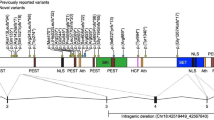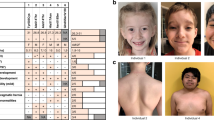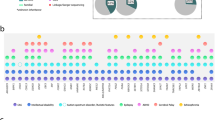Abstract
Individuals affected with developmental disorders of speech and language have substantial difficulty acquiring expressive and/or receptive language in the absence of any profound sensory or neurological impairment and despite adequate intelligence and opportunity1. Although studies of twins consistently indicate that a significant genetic component is involved1,2,3, most families segregating speech and language deficits show complex patterns of inheritance, and a gene that predisposes individuals to such disorders has not been identified. We have studied a unique three-generation pedigree, KE, in which a severe speech and language disorder is transmitted as an autosomal-dominant monogenic trait4. Our previous work mapped the locus responsible, SPCH1, to a 5.6-cM interval of region 7q31 on chromosome 7 (ref. 5). We also identified an unrelated individual, CS, in whom speech and language impairment is associated with a chromosomal translocation involving the SPCH1 interval6. Here we show that the gene FOXP2, which encodes a putative transcription factor containing a polyglutamine tract and a forkhead DNA-binding domain, is directly disrupted by the translocation breakpoint in CS. In addition, we identify a point mutation in affected members of the KE family that alters an invariant amino-acid residue in the forkhead domain. Our findings suggest that FOXP2 is involved in the developmental process that culminates in speech and language.
This is a preview of subscription content, access via your institution
Access options
Subscribe to this journal
Receive 51 print issues and online access
$199.00 per year
only $3.90 per issue
Buy this article
- Purchase on Springer Link
- Instant access to full article PDF
Prices may be subject to local taxes which are calculated during checkout




Similar content being viewed by others
References
Bishop, D. V. M., North, T. & Donlan, C. Genetic basis for specific language impairment: evidence from a twin study. Dev. Med. Child Neurol. 37, 56–71 (1995).
Tomblin, J. B. & Buckwalter, P. R. Heritability of poor language achievement among twins. J. Speech Lang. Hear. Res. 41, 188–199 (1998).
Dale, P. S. et al. Genetic influence on language delay in two-year-old children. Nature Neurosci. 1, 324–328 (1998).
Hurst, J. A., Baraitser, M., Auger, E., Graham, F. & Norell, S. An extended family with a dominantly inherited speech disorder. Dev. Med. Child Neurol. 32, 347–355 (1990).
Fisher, S. E., Vargha-Khadem, F., Watkins, K. E., Monaco, A. P. & Pembrey, M. E. Localization of a gene implicated in a severe speech and language disorder. Nature Genet. 18, 168–170 (1998).
Lai, C. S. L. et al. The SPCH1 region on human 7q31: genomic characterization of the critical interval and localization of translocations associated with speech and language disorder. Am. J. Hum. Genet. 67, 357–368 (2000).
Gopnik, M. & Crago, M. B. Familial aggregation of a developmental language disorder. Cognition 39, 1–50 (1991).
Vargha-Khadem, F., Watkins, K., Alcock, K., Fletcher, P. & Passingham, R. Praxic and nonverbal cognitive deficits in a large family with a genetically transmitted speech and language disorder. Proc. Natl Acad. Sci. USA 92, 930–933 (1995).
Vargha-Khadem, F. et al. Neural basis of an inherited speech and language disorder. Proc. Natl Acad. Sci. USA 95, 12695–12700 (1998).
Margolis, R. L. et al. cDNAs with long CAG trinucleotide repeats from human brain. Hum. Genet. 100, 114–122 (1997).
Lai, E., Clark, K. L., Burley, S. K. & Darnell, J. E. Jr Hepatocyte nuclear factor 3/fork head or “winged helix” proteins: a family of transcription factors of diverse biologic function. Proc. Natl Acad. Sci. USA 90, 10421–10423 (1993).
Li, C. & Tucker, P. W. DNA-binding properties and secondary structural model of the hepatocyte nuclear factor 3/fork head domain. Proc. Natl Acad. Sci. USA 90, 11583–11587 (1993).
Kaufmann, E. & Knöchel, W. Five years on the wings of fork head. Mech. Dev. 57, 3–20 (1996).
Kaestner, K. H., Knöchel, W. & Martinez, D. E. Unified nomenclature for the winged helix/forkhead transcription factors. Genes Dev. 14, 142–146 (2000).
Shu, W., Yang, H., Zhang, L., Lu, M. M. & Morrisey, E. E. Characterization of a new subfamily of winged-helix/forkhead (fox) genes that are expressed in the lung and act as transcriptional repressors. J. Biol. Chem. 276, 27488–27497 (2001).
Clark, K. L., Halay, E. D., Lai, E. & Burley, S. K. Co-crystal structure of the HNF-3/fork head DNA-recognition motif resembles histone H5. Nature 364, 412–420 (1993).
Nishimura, D. Y. et al. The forkhead transcription factor gene FKHL7 is responsible for glaucoma phenotypes which map to 6p25. Nature Genet. 19, 140–147 (1998).
Mears, A. J. et al. Mutations of the forkhead/winged-helix gene, FKHL7, in patients with Axenfeld–Rieger anomaly. Am. J. Hum. Genet. 63, 1316–1328 (1998).
Clifton-Bligh, R. J. et al. Mutation of the gene encoding human TTF-2 associated with thyroid agenesis, cleft palate and choanal atresia. Nature Genet. 19, 399–401 (1998).
Fang, J. et al. Mutations in FOXC2 (MFH-1), a forkhead family transcription factor, are responsible for the hereditary lymphedema–distichiasis syndrome. Am. J. Hum. Genet. 67, 1382–1388 (2000).
Crisponi, L. et al. The putative forkhead transcription factor FOXL2 is mutated in blepharophimosis/ptosis/epicanthus inversus syndrome. Nature Genet. 27, 159–166 (2001).
Semina, E. V., Brownell, I., Mintz-Hittner, H. A., Murray, J. C. & Jamrich, M. Mutations in the human forkhead transcription factor FOXE3 associated with anterior segment ocular dysgenesis and cataracts. Hum. Mol. Genet. 10, 231–236 (2001).
Wildin, R. S. et al. X-linked neonatal diabetes mellitus, enteropathy and endocrinopathy syndrome is the human equivalent of mouse scurfy. Nature Genet. 27, 18–20 (2001).
Bennett, C. L. et al. The immune dysregulation, polyendocrinopathy, enteropathy, X-linked syndrome (IPEX) is caused by mutations of FOXP3. Nature Genet. 27, 20–21 (2001).
Brunkow, M. E. et al. Disruption of a new forkhead/winged-helix protein, scurfin, results in the fatal lymphoproliferative disorder of the scurfy mouse. Nature Genet. 27, 68–73 (2001).
De Felice, M. et al. A mouse model for hereditary thyroid dysgenesis and cleft palate. Nature Genet. 19, 395–398 (1998).
Smith, R. S. et al. Haploinsufficiency of the transcription factors FOXC1 and FOXC2 results in aberrant ocular development. Hum. Mol. Genet. 9, 1021–1032 (2000).
Lehmann, O. J. et al. Chromosomal duplication involving the forkhead transcription factor gene FOXC1 causes iris hypoplasia and glaucoma. Am. J. Hum. Genet. 67, 1129–1135 (2000).
Nishimura, D. Y. et al. A spectrum of FOXC1 mutations suggests gene dosage as a mechanism for developmental defects of the anterior chamber of the eye. Am. J. Hum. Genet. 68, 364–372 (2001).
Cummings, C. J. & Zoghbi, H. Y. Fourteen and counting: unraveling trinucleotide repeat diseases. Hum. Mol. Genet. 9, 909–916 (2000).
Acknowledgements
We are deeply indebted to the KE family whose continued cooperation has made this research possible. We also thank CS and family for agreeing to participate in this study. We thank D. C. Jamison and E. D. Green for facilitating completion of the 7q31 genomic sequence; M. Fox, S. Jeremiah and S. Povey for the chromosome 7 hybrids; E. R. Levy for assistance with cytogenetic analyses; D. I. Stuart, E. Y. Jones and R. M. Esnouf for advice on structural analyses of forkhead domains; L. Rampoldi for assistance with northern blots; and E. Dunne for help with sequence analyses of other 7q31 candidate genes. Chromosome 7 sequence data were generated by the Washington University Genome Sequencing Center. This study was funded by the Wellcome Trust. A.P.M. is a Wellcome Trust Principal Research Fellow.
Author information
Authors and Affiliations
Corresponding author
Supplementary information

Figure S1
(JPG 10.6 KB)
Northern blot analyses of adult and foetal tissues with a probe containing exons 8-11 of FOXP2 reveals a transcript of ~6.5kb. Results from the control probe beta-actin are also shown. Tissues analysed were heart (H), brain (B), placenta (Pl), lung (Lu), liver (Li), skeletal muscle (S), kidney (K) and pancreas (Pa). The difference between the size of the transcript observed here and that of the open reading frame (2.1kb) indicates the presence of large 5’ and/or 3’ untranslated regions that may be involved in regulating expression of the gene.
Rights and permissions
About this article
Cite this article
Lai, C., Fisher, S., Hurst, J. et al. A forkhead-domain gene is mutated in a severe speech and language disorder. Nature 413, 519–523 (2001). https://doi.org/10.1038/35097076
Received:
Accepted:
Issue Date:
DOI: https://doi.org/10.1038/35097076
This article is cited by
-
More than a decade of genetic research on the Denisovans
Nature Reviews Genetics (2024)
-
Novel FOXP2 variant associated with speech and language dysfunction in a Chinese family and literature review
Journal of Applied Genetics (2024)
-
Possible roles of deep cortical neurons and oligodendrocytes in the neural basis of human sociality
Anatomical Science International (2024)
-
High-precision spatial analysis of mouse courtship vocalization behavior reveals sex and strain differences
Scientific Reports (2023)
-
TCF7L2 acts as a molecular switch in midbrain to control mammal vocalization through its DNA binding domain but not transcription activation domain
Molecular Psychiatry (2023)
Comments
By submitting a comment you agree to abide by our Terms and Community Guidelines. If you find something abusive or that does not comply with our terms or guidelines please flag it as inappropriate.



